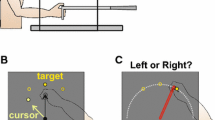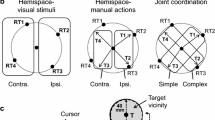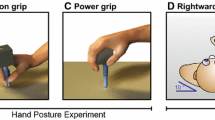Abstract
Does the brain use a separate internal model for cursor mechanics during visuomotor adaptation? We compared the amount of adaptation and transfer to the opposite arm when subjects reached the targets under different viewing conditions of the arm during reaching. If the brain forms separate models, we predict a difference in the amount of adaptation and transfer for each viewing condition. If the brain forms one model, we predict equivalent amounts of adaptation and transfer between the two hands for each viewing condition. Separate groups of subjects performed a reaching task with either a rotated view of cursor motion representing their unseen hand or a rotated view of their actual hand. The two groups were further divided so that the magnitude of the rotation was either 45° or 75° counter-clockwise. After adapting to the rotation with one hand, subjects reached the same targets under the same viewing condition but with the opposite hand. Similar amounts of adaptation and intermanual transfer were found across the different magnitudes of rotation and across patterns of hand-order. Our results suggest that the brain may not be learning a distinct model for cursor mechanics, or if it is, it must be equivalent or overlapping with the arm model.




Similar content being viewed by others
References
Abeele S, Bock O (2003) Transfer of sensorimotor adaptation between different movement categories. Exp Brain Res 148:128–132
Berniker M, Kording K (2008) Estimating the sources of motor errors for adaptation and generalization. Nat Neurosci 11:1454–1461
Choe CS, Welch RB (1974) Variables affecting the intermanual transfer and decay of prism adaptation. J Exp Psychol 102:1076–1084
Clower DM, Boussaoud D (2000) Selective use of perceptual recalibration versus visuomotor skill acquisition. J Neurophysiol 84:2703–2708
Cothros N, Wong JD, Gribble PL (2006) Are there distinct neural representations of object and limb dynamics? Exp Brain Res 173:689–697
Criscimagna-Hemminger SE, Donchin O, Gazzaniga MS, Shadmehr R (2003) Learned dynamics of reaching movements generalize from dominant to nondominant arm. J Neurophysiol 89:168–176
Dionne JK, Henriques DYP (2008) Interpreting ambiguous visual information in motor learning. J Vis 8:1–10
Dizio P, Lackner JR (1995) Motor adaptation to Coriolis force perturbations of reaching movements: endpoint but not trajectory adaptation transfers to the nonexposed arm. J Neurophysiol 74:1787–1792
Galea JM, Miall RC, Woolley DG (2007) Asymmetric interlimb transfer of concurrent adaptation to opposing dynamic forces. Exp Brain Res 182:267–273
Ghilardi MF, Gordon J, Ghez C (1995) Learning a visuomotor transformation in a local area of work space produces directional biases in other areas. J Neurophysiol 73:2535–2539
Graziano SA, Cooke DF, Taylor CSR (2000) Coding the location of the arm by sight. Science 290:1782–1786
Held R, Bauer JA Jr (1974) Development of sensorially-guided reaching in infant monkeys. Brain Res 71:265–271
Klassen J, Tong C, Flanagan JR (2005) Learning and recall of incremental kinematic and dynamic sensorimotor transformations. Exp Brain Res 164:250–259
Kluzik J, Diedrichsen J, Shadmehr R, Bastian AJ (2008) Reach adaptation: what determines whether we learn an internal model of the tool or adapt the model of our arm? J Neurophysiol 100:1455–1464
Malfait N, Ostry DJ (2004) Is interlimb transfer of force-field adaptation a cognitive response to the sudden introduction of load? J Neurosci 24:8084–8089
Mattar AA, Gribble PL (2005) Motor learning by observing. Neuron 46:153–160
Mercier C, Aballea A, Vargas CD, Paillard J, Sirigu A (2008) Vision without proprioception modulates cortico-spinal excitability during hand motor imagery. Cereb Cortex 18:272–277
Nyberg L, Eriksson J, Larsson A, Marklund P (2006) Learning by doing versus learning by thinking: an fMRI study of motor and mental training. Neuropsychologia 44:711–717
Obayashi S, Suhara T, Kawabe K, Okauchi T, Maeda J, Akine Y, Onoe H, Iriki A (2001) Functional brain mapping of monkey tool use. Neuroimage 14(4):853–861
Parlow SE, Kinsbourne M (1989) Asymmetrical transfer of training between hands: implications for interhemispheric communication in normal brain. Brain Cogn 11:98–113
Sainburg RL (2002) Evidence for a dynamic-dominance hypothesis of handedness. Exp Brain Res 142:241–258
Sainburg RL, Kalakanis D (2000) Differences in control of limb dynamics during dominant and nondominant arm reaching. J Neurophysiol 83:2661–2675
Sainburg RL, Wang J (2002) Interlimb transfer of visuomotor rotations: independence of direction and final position information. Exp Brain Res 145:437–447
Shadmehr R, Moussavi ZM (2000) Spatial generalization from learning dynamics of reaching movements. J Neurosci 20:7807–7815
Sober SJ, Sabes PN (2005) Flexible strategies for sensory integration during motor planning. Nat Neurosci 8:490–497
Taub E, Goldberg LA (1973) Prism adaptation: control of intermanual transfer by distribution of practice. Science 180:755–757
Wang J, Sainburg RL (2003) Mechanisms underlying interlimb transfer of visuomotor rotations. Exp Brain Res 149:520–526
Wang J, Sainburg RL (2007) The dominant and nondominant arms are specialized for stabilizing different features of task performance. Exp Brain Res 178:565–570
Wolpert DM, Ghahramani Z, Jordan MI (1995) An internal model for sensorimotor integration. Science 269:1880–1882
Acknowledgments
The authors gratefully acknowledge Dr. Erin Cressman and Aidan Thompson for their helpful suggestions on the manuscript and John Stemberger and Kemar Trenchfield for their programming expertise. This work was funded by grants from the Canadian Institute of Health Research (CIHR), Institute of Musculoskeletal Health and Arthritis (IMHA) and the Banting Research Foundation. D.Y.P. Henriques is an Alfred P Sloan fellow.
Author information
Authors and Affiliations
Corresponding author
Rights and permissions
About this article
Cite this article
Balitsky Thompson, A.K., Henriques, D.Y.P. Visuomotor adaptation and intermanual transfer under different viewing conditions. Exp Brain Res 202, 543–552 (2010). https://doi.org/10.1007/s00221-010-2155-0
Received:
Accepted:
Published:
Issue Date:
DOI: https://doi.org/10.1007/s00221-010-2155-0




